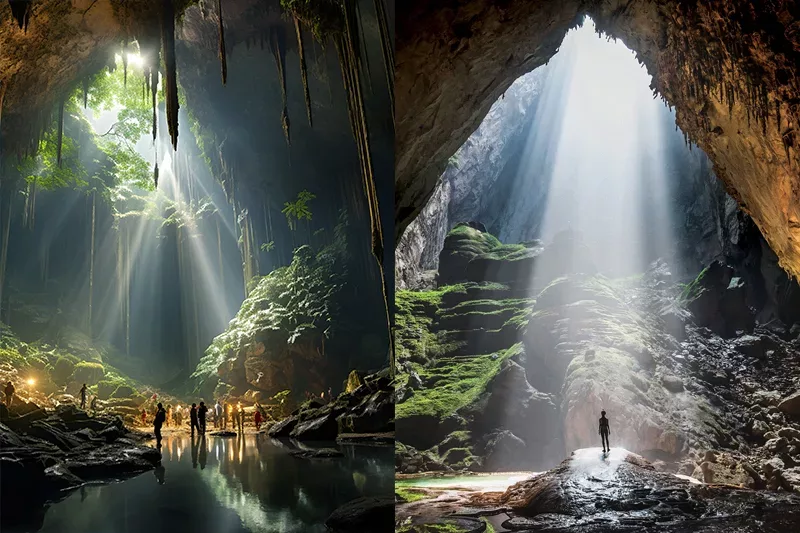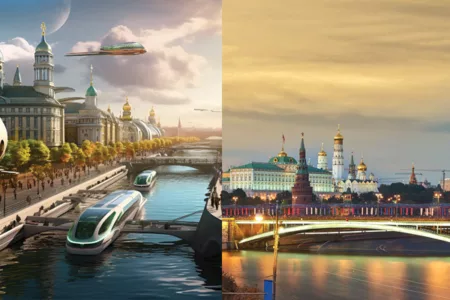
وبلاگ سپهران | Artificial Intelligence | World Trends Written by AI
When we decided to unveil the world trends, the first thing that came to our mind was to go to artificial intelligence and ask the opinion of this newly-arrived assistant. Therefore, we asked the AI to provide us with a list of the world trends; from the world’s largest and smallest to the oldest, most expensive, coldest, hottest, tallest, and busiest, you may have read about them before, or are new to you.
We decided to travel with artificial intelligence to the world’s amazing geographical territories, to know the unique features of the bests surrounding us.
Experience this journey full of surprises with us and discover the most prominent features that have shaped our world, open your mind and let Fly Sepehran open a gate of adventure for you.
* The textual content and photos of this article are prepared by artificial intelligence (ChatGPT and Midjourney).

The Airbus A380, the world’s most massive passenger aircraft, can hold around 850 passengers across its two floors. Its wings stretch wider than a football field, and the plane’s weight is comparable to five blue whales or 165 elephants. This colossal aircraft can accommodate about 120,206 cars on its wings, and its wingspan is twice the distance covered by the Wright brothers in their initial flight.
Taking a trip on the A380 offers passengers an unmatched travel experience. It presents unparalleled in-flight comfort standards, whether in economy or first-class. As the world’s roomiest passenger plane, its cabin offers a peaceful and relaxed ambiance for passengers to stretch out. Given the freedom it offers for passengers to move around, the A380 is popular across all cabin classes. Its benefits include a lower fuel burn per passenger and reduced operating costs per seat.
Introduced in December 2000, the 555-seat Airbus A380-800 has an uninterrupted flight range of 8,000 nautical miles. Production kicked off in January 2002, and the first flight equipped with Rolls-Royce engines took off from Blagnac Airport, Toulouse, in April 2005. Over 100 test flights were completed before its inaugural commercial flight by Singapore Airlines from Singapore to Sydney on October 25, 2007.
The A380 stands as the world’s largest and heaviest passenger aircraft, measuring 73 meters in length, 24 meters in height, and a maximum takeoff weight of 560 tons. It has undoubtedly set a new precedent in the global aviation industry. The A380 has transformed passenger comfort and significantly improved environmental standards, boasting low fuel consumption per passenger, reduced noise levels, and decreased CO2 and NOx emissions. These advancements have significantly influenced future generations of aircraft.

The Royal Suite at the Grand Hills Hotel & Spa in Broumana, Lebanon, stands as the world’s largest hotel suite among the world trends sprawling over 4131 square meters across six floors, embedded within a landscape of private gardens and swimming pools.
Situated in the hills above Beirut, roughly 17 kilometers from the city center, Grand Hills Broumana presents a superb resort. This hotel features a verdant garden housing over 1200 artworks, sculptures, antiques, and handcrafted furnishings. Each room in this suite-hotel is intricately designed following an international theme.
The hotel complex includes an extensive range of massage treatments and wellness experiences in its spa and an opportunity for guests to work out in a fitness center. With 164 uniquely decorated rooms and suites, guests can soak in panoramic views of either the mountain range or the Mediterranean Sea. The excellently designed Royal Suite at the Grand Hills Hotel has earned its spot in the Guinness World Records as the world’s largest suite.
Located in a mountainous region just outside of Beirut, Grand Hills Hotel & Spa offers an ideal venue for a variety of occasions, from successful meetings and conferences to lavish social gatherings and grand weddings. In addition to a business center composed of six rooms, the resort boasts a grand ballroom, a 350-seat amphitheater, and two open-air venues. Immersed in the pine-forested hills of Broumana, Grand Hills, with its legendary gardens and majestic halls, provides an unrivaled setting for memorable wedding celebrations.
The luxurious Grand Hills Hotel & Spa offers multiple dining and drinking venues, including the Pool Cafe serving Mediterranean cuisine, and Chez Alain Restaurant, which presents a blend of modern French, Indian, and Chinese flavors. Notably, the Mar Chaaya Chapel and Beirut Zoo are only four kilometers away from the hotel.

Hang Son Doong, based on its volume, is the largest cave in Vietnam and the world, discovered by Ho Khanh, a local jungle man, in 1990. The length of Son Doong cave is close to 9 kilometers and its volume is estimated to be up to 38.5 million cubic meters, making it the largest natural cave on earth and among the list of world trends. However, what makes Hang Son Doong unique and well-known to people around the world is the hidden and unique underground world inside the cave. This cave has complex and gigantic stalactites with heights exceeding 80 meters. Rainforests growing inside the cave, the cave ecosystem, the climate, and a mysterious underground river that no explorer has yet discovered the end of, form the mysterious world inside the cave.
Experts estimate that a 40-story skyscraper could easily fit in the cave’s passageway, and the cave is so large that a Boeing 747 could easily pass through it. The world’s tallest stalagmite, about 80 meters tall, is also located in this passageway.
With such a vast size, Son Doong has its own unique weather system; the temperature of the cave air in summer is between 22 and 25 degrees Celsius and in winter it is around 15 to 20 degrees Celsius. Overall, in summer, the temperature inside the cave is 8 to 12 degrees Celsius cooler than outside, which in the absence of sunlight, humid atmosphere, and air pressure difference, causes airflow in it.
Son Doong Cave is located in the central region of Phong Nha – Ke Bang National Park, near the border of Laos and Vietnam, and has been registered twice as a World Heritage Site by UNESCO in 2003 and 2015.
Thanks to Son Doong, a variety of tours and services have developed around the cave. Numerous accommodations and hotels were built for tourists, and many residents of local communities have found sustainable income jobs. The Hang Son Doong tour has created job opportunities for 125 people in Phong Nha and hundreds of indirect jobs for local people by providing food supplies, accommodations, transportation, and many other areas.

Air travel has become one of the principal modes of transport today, and more tourists are using airplanes for their journeys day by day. Istanbul’s new airport is one of the most advanced and beautiful airports in the world, located in the Arnavutköy area in the European part of Istanbul. This airport transported over 64 million passengers in 2022, making it the busiest airport in Europe and the seventh-busiest airport in the world in terms of total passenger traffic.
Istanbul’s new airport, about 35 kilometers outside of Istanbul, between the residential areas of Yeniköy and Akpınar, along the Black Sea coast, replaced Atatürk International Airport in April 2019. The Airports Council International (ACI) introduced Istanbul’s new airport as the “Best Airport in Europe” in October 2021.
Istanbul’s new airport, the largest airport in the world and the most important global hub in the region continues to be approved by international institutions with its strong infrastructure, superior technology, and excellent travel experience. This airport has four terminals, six runways, 165 passenger bridges, three technical buildings, eight control towers, 16 taxi transport routes, and an area with a capacity to accommodate 500 airplanes. Istanbul’s airport is planned to have a 150,000 square meter ground services campus and a 1.4 million square meter cargo city.
Getting to and from Istanbul airport to different parts of the city is easier than you might think; a 34-kilometer metro line was launched at this airport in January 2023, allowing passengers to reach the airport in 25 minutes. Currently, many airlines from different countries around the world operate at this airport. For this reason, Istanbul’s new airport has managed to become one of the world’s most prominent airports.

Russia, with a land area of over 17 million square kilometers, is recognized as the world’s largest country in terms of landmass. This country extends from Asia to Europe and is one of the few nations situated on two continents, Asia and Europe. Russia comprises nine different time zones and shares land borders with 14 neighboring countries. To better understand, imagine the approximate expanse of Russia as twice the size of the entirety of the United States, over four times the size of Canada, and about 70 times larger than Britain. Although Russia covers approximately 17% of the world’s habitable lands, only 2% of the world’s population resides in this region.
Within this vast territory, numerous cities are popular tourist destinations. Moscow, the capital of Russia, with its astonishing architecture, the Kremlin Palace, and the Red Square – both on the UNESCO World Heritage List – along with dozens of other attractions, attracts millions of international tourists from all over the world. Furthermore, its prominent operas and museums house countless works of art.
Saint Petersburg is another city that cannot be overlooked. Known as the “Venice of the North”, the city is famous for its beautiful canals and majestic palaces, and its rich historical and cultural heritage. Saint Petersburg is home to the Hermitage, one of the world’s largest art museums.
Russia’s natural landscape ranges from deserts to ice-clad coastlines, towering mountains to vast marshes. Most of Russia consists of treeless plains known as steppes. Siberia, which occupies three-fourths of Russia, is nestled among extensive pine forests called taiga. The country has around 100,000 rivers and several lakes.
Lake Baikal, the deepest lake in the world, located in the Siberian region of Russia, offers unique natural scenery. The country experiences a cold polar climate; with freezing winters and mild summers. In some areas, like Siberia, the temperature can drop to minus 50 degrees Celsius. In contrast, in the southern regions, like the Black Sea coasts, the climate is Mediterranean.
Russia owes a part of its fame to thinkers and artists like Leo Tolstoy and Fyodor Dostoevsky, and composers like Pyotr Ilyich Tchaikovsky.
The best time to visit Russia depends on the type of activity you intend to undertake. If you are traveling to see cities and historical sites, the best time is from May to September, when the weather is warmer and the days are longer. If you’re interested in winter sports and activities, the winter months, especially December to February, are more suitable to visit this among the world trends.

Imagine for a moment swimming in a natural pool in the middle of a forest in Venezuela while gazing a kilometer above at the tallest waterfall in the world.
Angel Falls, or Salto Ángel in Spanish, is the highest waterfall in the world and part of the longest rivers in South America. This waterfall is located deep within the rainforests of Venezuela and can only be accessed by plane and then by boat. It is this remoteness that attracts adventurous tourists from all over the world to visit it. The mesmerizing location of Angel Falls has also served as inspiration for many novels and films.
Angel Falls in Venezuela is known for its height, surpassing 800 meters (2,600 feet), and holds the title of the tallest waterfall in the world. This awe-inspiring waterfall was discovered by pilot James Angel in 1933 when he was flying over the Venezuelan jungle. Since that moment, Angel Falls has become a symbol of Venezuela and took its name from the pilot James Angel. The estimated height of this waterfall is 979 meters (3,212 feet).
This waterfall is situated in Canaima National Park (Parque Nacional Canaima) in the Bolívar state, southeast Venezuela. This park is so significant that it has been listed as a UNESCO World Heritage Site.
The geography of the region contributes to the formation of Angel Falls and many other waterfalls in its vicinity. The famous table-top mountains known as tepui or tepuy, with their flat summit plateaus rising from the heart of the earth, create a unique landscape and give birth to wonders like Angel Falls. To better grasp the magnitude of Angel Falls, consider comparing its height with other famous waterfalls in the world. Niagara Falls on the border of Canada and the United States, with a height of 50 meters (165 feet), is approximately 20 times shorter than Angel Falls. Additionally, Victoria Falls in Southern Africa, with a height of 108 meters (354 feet), falls short of Angel Falls’ height.

Humans are adventurous beings who constantly embark on long and challenging journeys to find the necessary resources for survival, growth, and prosperity. This spirit of adventure has led to the creation of cities with extreme characteristics in this vast world.
Yakutsk, the capital of the Sakha Republic in Russia, located just 450 kilometers south of the Arctic Circle, is a city with the distinction of being the coldest city in the world. The inhabitants of this city, known as the Sakha people, migrated to this region from other parts of Siberia during the 13th and 14th centuries. Despite the severe cold, Yakutsk has attractions such as the Ice Museum, the National Art Museum, and the Kristin Market, which have made it a popular destination for tourists who are not bothered by the freezing temperatures. Apparently, the only Mammoth Museum in the world is also located in this city.
Yakutsk was founded as a Russian fort by Pyotr Beketov in 1632. The city had a population of approximately 311,760 people as of 2018. It experiences only a few relatively warm months when life thrives. In summer, the temperature can reach 30 degrees Celsius, but during the long and cold winter season, thermometers often indicate temperatures of -40 to -52 degrees Celsius. Winter in this city starts in October and lasts until May.
One of the best attractions in Yakutsk is the Lena Pillars Nature Park, which is listed as a UNESCO World Heritage Site. This park is located near the Lena River and is only slightly smaller than the Amazon River.
Yakutsk has fewer tourist attractions compared to other Russian cities. However, it attracts the attention of many tourists. Nevertheless, reaching this city is not easy, and traveling from one place to another sometimes takes longer than usual. Nonetheless, the territory of Yakutsk is vast and can be compared to France or Britain.

The busiest airports in the world are announced annually by the International Air Transport Association (IATA) and the Airports Council International (ACI). Interestingly, for several consecutive years, Hartsfield-Jackson Atlanta International Airport has claimed this title. Nearly 94 million passengers used Hartsfield-Jackson Airport for their travels in 2022, which marks an approximately 23.8% increase compared to 2021.
The strategic location of this airport and its role as the primary hub for one of the largest airlines in the world have made it the busiest airport globally. However, the busiest airport in the world is not as chaotic and unsettling as one might expect, as Hartsfield-Jackson has also earned the title of the most efficient airport worldwide, maintaining this honor for 14 consecutive years.
One of the main reasons for the success and popularity of Hartsfield-Jackson International Airport is the significant presence of Delta Air Lines. This legacy carrier of the United States and a founding member of the SkyTeam alliance has chosen Atlanta as one of its major hubs.
Atlanta Airport boasts the tallest air traffic control tower in North America and the third tallest in the world. It is also the largest employer in the state of Georgia, with over 60,000 people working in various roles, from operators to air traffic controllers. The airport offers extensive amenities, including six Starbucks outlets and permanent art exhibitions.
Many residents of Atlanta are astonished to learn that the Flint River begins just north of the airport and flows beneath it. The second-longest river in the state of Georgia, the Flint, continues its course for 344 miles to the south, joins the Chattahoochee River on the Florida border, forms the Apalachicola River, and ultimately reaches the Gulf of Mexico.

Nishiyama Onsen Keiunkan, located in Yamashiro, Japan, is the oldest hotel in the world. This hotel has been in operation since 705 AD and has gained a good reputation as a hotel and hot spring.
The Keiunkan Hotel, which is said to be 1317 years old, was recognized by Guinness World Records in 2011 as the oldest hotel in the world. It is located at the foot of Mount Akaishi and has been sourcing all of its hot spring water from the local Hakuhou Springs since its establishment.
The Keiunkan Hotel has been owned and managed by one family for 52 generations, making it the oldest family-run hotel in the world. Despite evolving into a modern hotel over generations, the Keiunkan Hotel has managed to preserve its unique charm and features. With the hotel’s modernization, the rooms have been equipped with amenities to create a peaceful and relaxing atmosphere, allowing guests to experience the utmost enjoyment during their stay and indulge in the legendary hospitality of the Shogun samurais at the hot springs of the Kyoto Mountains.
As the oldest hotel in the world, it boasts several hot springs that are internationally recognized for their soothing and therapeutic properties. Upon entering your beautiful Japanese-style room, you can enjoy the hot springs it offers. It’s worth mentioning that the hot springs of the Keiunkan Hotel have also achieved another Guinness World Record as the “Most Visited Hot Springs in the World.” The Keiunkan Hotel features 37 rooms, a Kaiseki restaurant, and an exciting platform for stargazing. Since 2019, all hotel rooms have been connected to high-speed free internet. The combination of tatami mats and classical art has given a beautiful touch to the rooms. The hotel staff wears a traditional Nibu-shiki kimono, which adds to the ambiance and captivates tourists.

The Vatican, the smallest country on the list of world trends, is located in Rome, Italy. With an area of 110 hectares and a population of fewer than 1000 people, the Vatican has become the smallest territory in the world. The magnificent St. Peter’s Square and the iconic St. Peter’s Basilica, considered the most important religious building in the world and the headquarters of the Catholic Church, along with the Vatican Museums, the Sistine Chapel, and Michelangelo’s masterpiece, known as the largest collection of art in the world, are the unique attractions of this small territory.
Approximately 600 of the Vatican’s population of one thousand people live in the city of Rome, while the remaining four hundred are considered Vatican citizens but reside outside the Vatican. Therefore, the population density in this country is just a number.
In this country, the economy is supported by the sale of stamps, coins, medals, and tourist memorabilia, as well as entrance fees to museums and the sale of publications. The Vatican issues its own special coins and stamps and, since January 1, 1999, introduced the euro as its official currency due to a special agreement with the European Union. Euro coins and banknotes have been in circulation in the Vatican since January 1, 2002, and due to the rarity of Vatican euro coins, they have attracted significant attention from collectors.
Throughout the centuries, the Vatican has disclosed limited information about its financial condition and investments, so it is not widely known how the Vatican generates income as an independent country with its own economy.
Although the Vatican is the smallest country in terms of size, it has a significant impact on the global economy through extensive investments in banking, real estate, and the establishment of private companies.
It is worth noting that the Vatican does not have a hospital, so no one can be born there. Vatican citizenship is not obtained by birth but rather through employment in the Vatican.

The mesmerizing beauty of the night sky, adorned with millions of stars, is one of the most dreamlike scenes one can imagine. The inner tranquility that accompanies spending one or more nights under the starry sky in the heart of the vast and silent Shahdad Desert amplifies the joy of your journey multiple times over.
Shahdad boasts a hot desert climate, making it one of the hottest and driest places on Earth. Its summers are scorching and longer than anywhere else, while its winters are shorter and milder.
Being only 100 kilometers away from the historic city of Kerman, Shahdad holds the title of the hottest place on Earth among the world trends list. It stretches towards the vast Lut Desert (Dasht-e Lut) from the east, with only a 30-kilometer distance to Lut, a UNESCO-registered natural heritage site. Shahdad also overlooks a plain known as “Tekab,” which forms the main part of the “Khabis” desert.
With an elevation of only 56 meters above sea level, Shahdad claims the title of the hottest place in Iran and on the Earth. A part of this scorched desert is referred to as “Gandom Beryan,” meaning “roasted wheat grain.” The temperature in this region even surpasses that of the “Death Valley in Southern California.” NASA declared Shahdad’s temperature to be 70 degrees Celsius in 2005. It is no wonder that Shahdad is recognized among geographers as one of the “thermal poles” of the Earth.
The natural heritage of Kaluts in Shahdad, dating back 6000 years, is believed to have been the capital of the ancient “Aratta” mentioned in Sumerian mythology. It is said that the oldest metal flag of Iran, the Derafsh-e Shahdad, was discovered in this region. Geographers’ reports suggest that great civilizations once thrived in this area.
The only perennial river in this region is called the “Shur River”. The Shur flows within the depths of the Lut Desert and remains full of water throughout the year. This river, one of the saltiest in the world, has accumulated the highest concentration of minerals. It passes approximately 200 kilometers southeast of Shahdad and then calmly rests in an area known as the “Cale- Madan Namak”.
In Shahdad’s desert, one cannot miss the vast salt flats spanning an area of 100 hectares, adorned with egg-shaped structures, which cannot be found anywhere else in the world.
What we said about the World Trends …
What we wrote was using artificial intelligence, which of course we added and edited a little. Although dealing with World Trends can be more than this, we decided to ask our new assistant (artificial intelligence) in other fields as well.
If there is any comment, please feel free to write us.